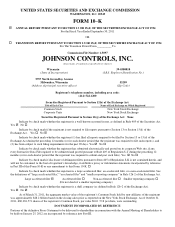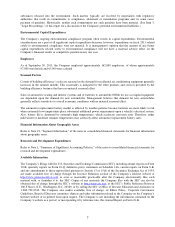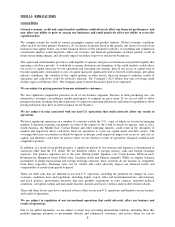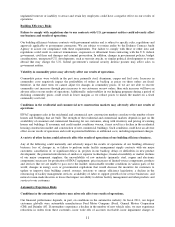Johnson Controls 2011 Annual Report Download - page 10
Download and view the complete annual report
Please find page 10 of the 2011 Johnson Controls annual report below. You can navigate through the pages in the report by either clicking on the pages listed below, or by using the keyword search tool below to find specific information within the annual report.10
Additionally, several of our credit agreements generally include an increase in interest rates if the ratings for our
debt are downgraded. Further, an increase in the level of our indebtedness may increase our vulnerability to adverse
general economic and industry conditions and may affect our ability to obtain additional financing.
We are subject to potential insolvency or financial distress of third parties.
We are exposed to the risk that third parties to various arrangements who owe us money or goods and services, or
who purchase goods and services from us, will not be able to perform their obligations or continue to place orders
due to insolvency or financial distress. If third parties fail to perform their obligations under arrangements with us,
we may be forced to replace the underlying commitment at current or above market prices or on other terms that are
less favorable to us. In such events, we may incur losses, or our results of operations, financial position or liquidity
could otherwise be adversely affected.
We may be unable to complete or integrate acquisitions effectively, which may adversely affect our growth,
profitability and results of operations.
We expect acquisitions of businesses and assets to play a role in our future growth. We cannot be certain that we
will be able to identify attractive acquisition targets, obtain financing for acquisitions on satisfactory terms or
successfully acquire identified targets. Additionally, we may not be successful in integrating acquired businesses
into our existing operations and achieving projected synergies. Competition for acquisition opportunities in the
various industries in which we operate may rise, thereby increasing our costs of making acquisitions or causing us to
refrain from making further acquisitions. We are also subject to applicable antitrust laws and must avoid
anticompetitive behavior. These and other acquisition-related factors may negatively and adversely impact our
growth, profitability and results of operations.
We are subject to business continuity risks associated with centralization of certain administrative functions.
Certain administrative functions, primarily in North America, Europe and Asia, have been or are in the process of
being regionally centralized to improve efficiency and reduce costs. To the extent that these central locations are
disrupted or disabled, key business processes, such as invoicing, payments and general management operations,
could be interrupted.
A failure of our information technology (IT) infrastructure could adversely impact our business and
operations.
We rely upon the capacity, reliability and security of our information technology infrastructure and our ability to
expand and continually update this infrastructure in response to the changing needs of our business. For example, we
are implementing new enterprise resource planning and other IT systems in certain of our businesses over a period
of several years. As we implement the new systems, they may not perform as expected. We also face the challenge
of supporting our older systems and implementing necessary upgrades. If we experience a problem with the
functioning of an important IT system or a security breach of our IT systems, the resulting disruptions could have an
adverse effect on our business.
We and certain of our third-party vendors receive and store personal information in connection with our human
resources operations and other aspects of our business. Despite our implementation of security measures, our IT
systems are vulnerable to damages from computer viruses, natural disasters, unauthorized access, cyber attack and
other similar disruptions. Any system failure, accident or security breach could result in disruptions to our
operations. A material network breach in the security of our IT systems could include the theft of our intellectual
property or trade secrets. To the extent that any disruptions or security breach results in a loss or damage to our data,
or in inappropriate disclosure of confidential information, it could cause significant damage to our reputation, affect
our relationships with our customers, lead to claims against the Company and ultimately harm our business. In
addition, we may be required to incur significant costs to protect against damage caused by these disruptions or
security breaches in the future.
Our business success depends on attracting and retaining qualified personnel.
Our ability to sustain and grow our business requires us to hire, retain and develop a highly skilled and diverse
management team and workforce. Failure to ensure that we have the leadership capacity with the necessary skill set
and experience could impede our ability to deliver our growth objectives and execute our strategic plan. Any























